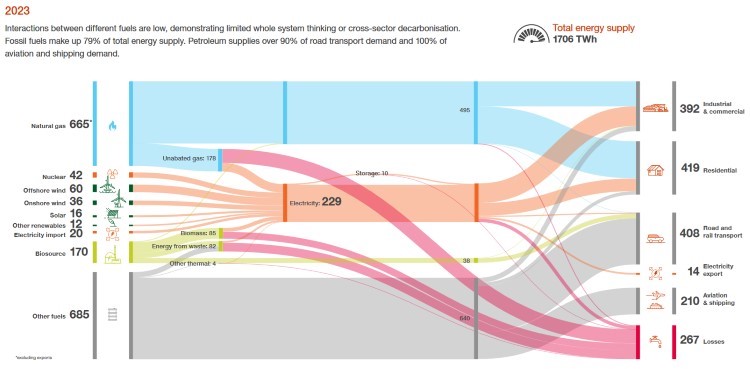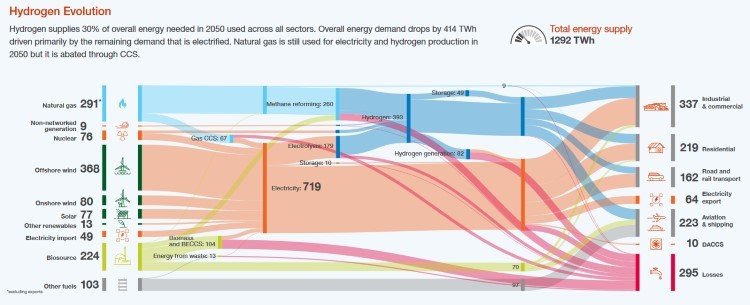17th July 2024
National Grid has released the latest update to their Future Energy Scenarios, FES2024. For an introduction to the FES2024 Pathways there is a series of four FES2024 webinars taking place this week on Wednesday 17th and Thursday 18th July, see below for details.
The ESO Pathways to Net Zero represent different, credible ways to decarbonise the UK energy system by 2050. FES 2024 has adopted a new framework to better present three pathways for net zero by 2050 with the Counterfactual scenario which shows how UK energy might look if decisive actions are not taken within the next two years to deliver the fundamental change required for a net zero UK energy system by 2050.
- Mixed Pathway: explores a route to net zero under a mixed technology development path.
- Electrification Pathway: explores a route to net zero under a highly electrified development path.
- Hydrogen Pathway: explores a route to net zero under a hydrogen development path
- Counterfactual: explores a world where not enough progress is made on decarbonisation and net zero 2050 is missed.
The previous FES framework, used since 2020, presented a wide range of credible outcomes on the route to net zero. This new framework seeks to explore a narrower range by identifying strategic choices that can be made on the route to net zero and forms part of a wider industry overhaul to Great Britain’s energy network planning.
The three new FES2024 pathways – Holistic Transition, Electric Engagement and Hydrogen Evolution – explore strategic routes to net zero based on extensive stakeholder engagement, research and analysis. In comparison, the Counterfactual is used to understand the gap between successful tracking of the pathways versus enabling change too slowly and missing key UK targets for Net Zero by 2050.
- Holistic Transition: 2050 energy demand for net zero is met through a mix of electrification and hydrogen, with hydrogen mainly around industrial clusters. Consumer engagement in the transition is very strong with demand shifting, with smart homes and electric vehicles providing flexibility to the grid.
- Electric Engagement: Net zero in 2050 is met through mainly electrified demand. Consumers are highly engaged in the energy transition through smart technologies that reduce energy demands, utilising technologies such as electric heat pumps and electric vehicles.
- Hydrogen Evolution: Net zero in 2050 met through fast progress for hydrogen in industry and heat. Many consumers will have hydrogen boilers, though energy efficiency will be key to reducing cost. There are low levels of consumer engagement. Hydrogen will be prevalent for heavy goods vehicles but electric car uptake is strong.
- Counterfactual: Net zero UK target for 2050 is missed, though some progress is made for decarbonisation compared to today. While home insulation improves, there is still a heavy reliance on gas across all sectors, particularly power and space heating. Electric vehicle uptake is slower than the net zero pathways, but still displaces petrol and diesel.
In 2023 the total UK energy demand was 1706 TWh with fossil fuels making up 79% of total UK energy supply. Petroleum supplied over 90% of road transport demand and 100% of aviation and shipping demand. Interactions between different fuels are low, demonstrating limited whole system thinking or cross-sector decarbonisation as illustrated below:

UK Energy Supply in 2023
By contrast the Hydrogen Evolution pathway predicts the total UK energy demand will reduce to 1292 TWh in large part due to improved energy efficiency measures. Hydrogen supplies 30% of overall energy needed in 2050 used across all sectors. Overall energy demand drops by 414 TWh, driven primarily by the remaining demand that is electrified. Natural gas is still used for electricity and hydrogen production in 2050 but it is abated through CCS.

UK energy supply and demand in 2050 – the FES2024 Hydrogen Evolution Pathway
The Hydrogen Evolution pathway uses high levels of hydrogen dispatchable power plants to lower needs for renewable and nuclear capacities, and CCS abated natural gas plants have lower utilisation post 2035. Hydrogen storage provides most flexibility in this pathway.
Link to FES2024 Pathways Summary